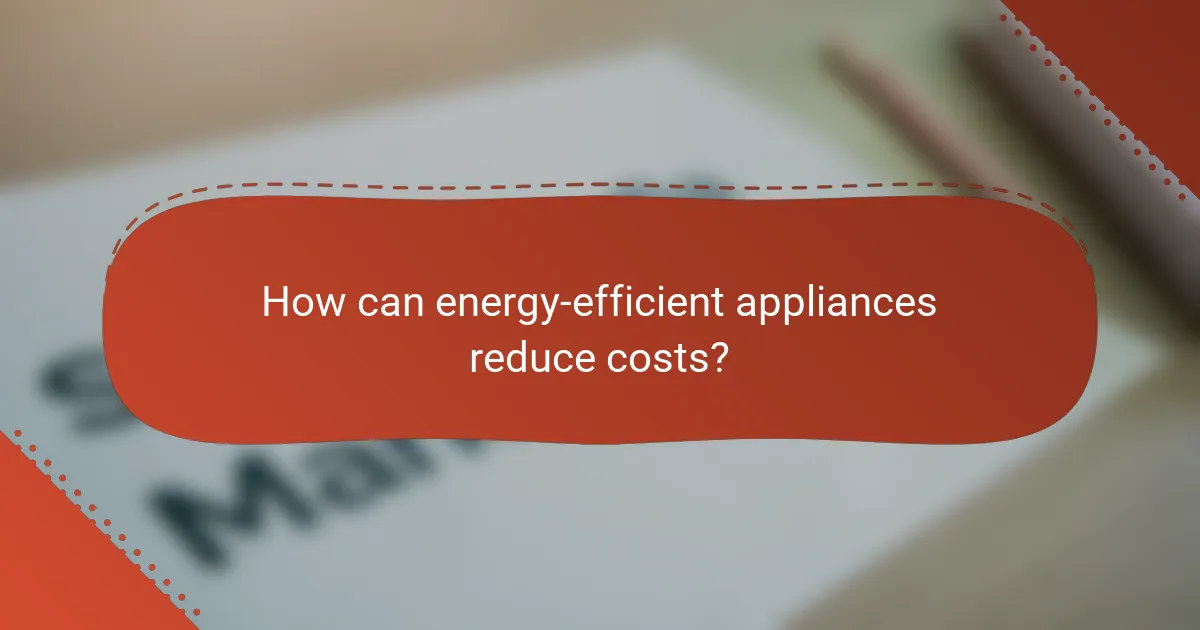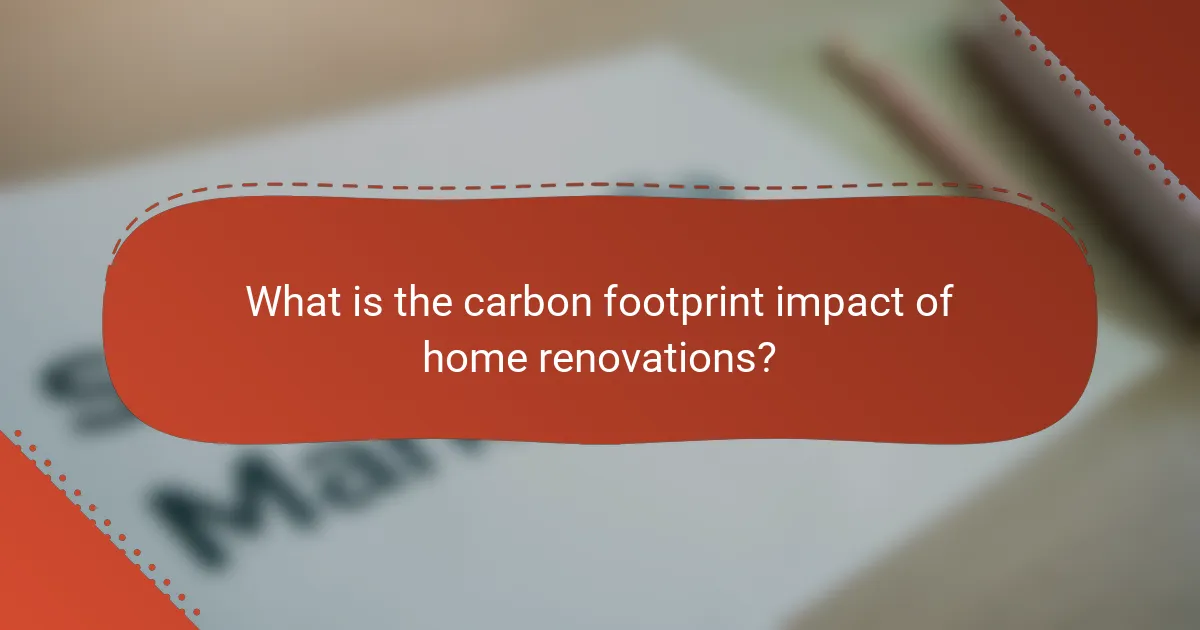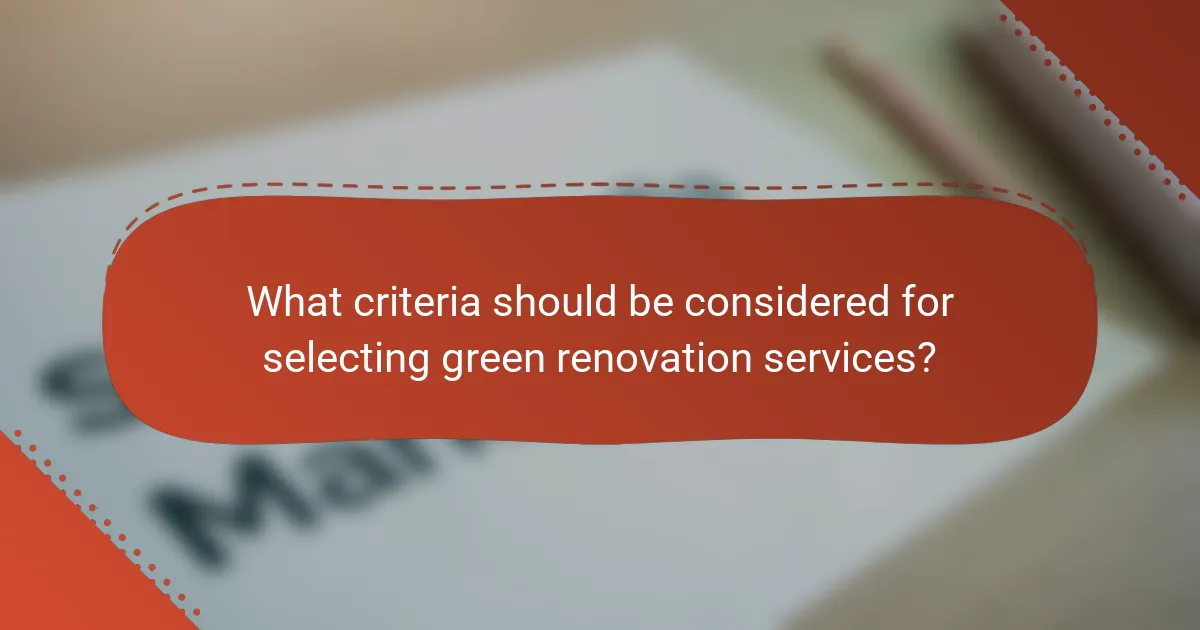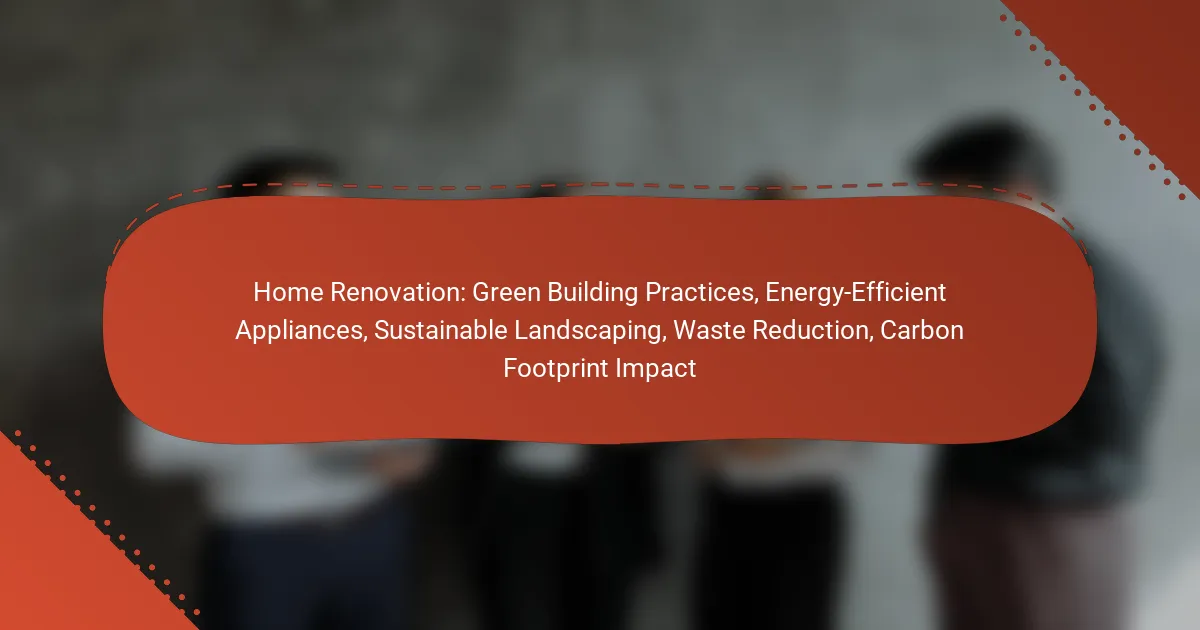Home renovation offers a unique opportunity to embrace green building practices that prioritize environmental responsibility and resource efficiency. By incorporating energy-efficient appliances, sustainable landscaping, and waste reduction strategies, homeowners can significantly reduce their carbon footprint while enhancing the comfort and value of their living spaces. These eco-friendly choices not only contribute to a healthier planet but also lead to long-term financial savings.

What are green building practices for home renovation?
Green building practices for home renovation focus on creating structures that are environmentally responsible and resource-efficient throughout their life cycle. These practices aim to minimize waste, reduce energy consumption, and enhance the overall sustainability of the home.
Energy-efficient materials
Using energy-efficient materials is crucial in green building practices. These materials, such as insulated concrete forms, energy-efficient windows, and high-performance insulation, help reduce energy consumption by maintaining comfortable indoor temperatures. When selecting materials, consider their thermal properties and long-term durability.
Look for products with high energy ratings and certifications, such as ENERGY STAR, to ensure you are making efficient choices. Investing in these materials can lead to significant savings on energy bills over time.
Water conservation techniques
Water conservation techniques are essential for reducing water usage in home renovations. Installing low-flow fixtures, such as faucets, showerheads, and toilets, can significantly decrease water consumption without sacrificing performance. Rainwater harvesting systems can also be integrated to collect and reuse rainwater for irrigation or non-potable uses.
Consider xeriscaping for landscaping, which involves using drought-resistant plants and minimizing lawn areas to reduce irrigation needs. These practices not only conserve water but can also lower utility costs.
Indoor air quality improvements
Improving indoor air quality is a key aspect of green building practices. This can be achieved by using low-VOC (volatile organic compounds) paints, finishes, and adhesives that minimize harmful emissions. Proper ventilation systems, such as energy recovery ventilators, can also enhance air quality by bringing in fresh air while reducing energy loss.
Regular maintenance of HVAC systems and the use of air purifiers can further improve indoor air quality, creating a healthier living environment for occupants.
Renewable energy integration
Integrating renewable energy sources, such as solar panels or wind turbines, is an effective way to enhance a home’s sustainability. Solar panels can significantly reduce reliance on grid electricity, leading to lower energy costs and a reduced carbon footprint. Consider local incentives or rebates that may be available for renewable energy installations.
When planning for renewable energy, assess your property’s solar potential and local regulations to ensure compliance and maximize efficiency.
Local sourcing of materials
Local sourcing of materials supports green building practices by reducing transportation emissions and supporting the local economy. Choose materials that are produced or harvested within a reasonable distance from your renovation site to minimize the carbon footprint associated with shipping.
Additionally, local materials often have a lower environmental impact and can enhance the character of your home. Look for reclaimed wood, locally manufactured products, or regional stone to incorporate into your renovation.

How can energy-efficient appliances reduce costs?
Energy-efficient appliances can significantly lower your household expenses by using less electricity and water compared to standard models. By investing in these appliances, homeowners can enjoy reduced utility bills and long-term savings, making them a financially smart choice.
Lower utility bills
Energy-efficient appliances consume less energy, which directly translates to lower utility bills. For example, an energy-efficient refrigerator can use up to 50% less electricity than older models, leading to savings of around $100 or more annually. This reduction in energy consumption is particularly beneficial during peak usage months when rates can be higher.
To maximize savings, consider appliances with the ENERGY STAR label, which indicates they meet strict efficiency guidelines set by the U.S. Environmental Protection Agency. These appliances not only save money but also contribute to a reduced carbon footprint.
Tax incentives for energy-efficient models
Many governments offer tax incentives for purchasing energy-efficient appliances, which can further reduce the initial investment cost. In the U.S., for instance, homeowners may qualify for federal tax credits or state rebates when buying ENERGY STAR certified products. These incentives can range from a few hundred to over a thousand dollars, depending on the appliance and local regulations.
Check with local tax authorities or energy efficiency programs to find specific incentives available in your area. This can help you make informed decisions and maximize your savings on energy-efficient upgrades.
Long-term savings on replacements
Investing in energy-efficient appliances often leads to long-term savings on replacements and maintenance. These models are typically built to last longer and require fewer repairs, which can save homeowners hundreds of dollars over time. For instance, an energy-efficient washing machine may last several years longer than a standard one, reducing the frequency of replacements.
When considering new appliances, factor in not just the purchase price but also the expected lifespan and operating costs. Choosing energy-efficient options can significantly lower your overall expenses in the long run, making them a wise investment for any homeowner.

What sustainable landscaping options are available?
Sustainable landscaping options focus on using eco-friendly practices and materials to create outdoor spaces that conserve resources and enhance biodiversity. Key methods include selecting native plants, implementing xeriscaping techniques, and installing rainwater harvesting systems.
Native plant selection
Choosing native plants is essential for sustainable landscaping as these species are adapted to the local climate and soil conditions. They require less water and maintenance compared to non-native varieties, making them a cost-effective choice for homeowners.
Additionally, native plants support local wildlife, including pollinators like bees and butterflies. When planning your garden, consider incorporating a variety of native species to create a balanced ecosystem.
Xeriscaping techniques
Xeriscaping is a landscaping method designed to reduce or eliminate the need for irrigation. This approach involves using drought-resistant plants, mulching, and efficient irrigation systems to conserve water.
To implement xeriscaping, start by assessing your landscape’s natural drainage and sun exposure. Group plants with similar water needs together, and use mulch to retain soil moisture. This practice not only saves water but can also lower your water bill significantly.
Rainwater harvesting systems
Rainwater harvesting systems capture and store rainwater for later use, providing an eco-friendly water source for irrigation and other outdoor needs. These systems can range from simple rain barrels to more complex underground cisterns.
When setting up a rainwater harvesting system, ensure it complies with local regulations regarding water collection. A well-designed system can reduce reliance on municipal water, lower costs, and promote sustainable water use in your landscaping efforts.

How to implement waste reduction strategies during renovation?
Implementing waste reduction strategies during renovation involves minimizing the amount of waste generated and ensuring that materials are reused or recycled whenever possible. This approach not only conserves resources but also reduces disposal costs and environmental impact.
Recycling construction materials
Recycling construction materials is a key strategy for reducing waste during renovations. Common materials such as wood, metal, and concrete can often be repurposed or recycled, diverting them from landfills. Check with local recycling centers to understand what materials they accept and any specific preparation required.
Consider creating a designated area on-site for sorted materials to streamline the recycling process. For example, you might separate scrap metal from wood and drywall to facilitate easier recycling later. Many municipalities offer incentives for recycling, which can help offset renovation costs.
Donation of usable items
Donating usable items is an effective way to reduce waste while benefiting others. Items such as appliances, fixtures, and furniture that are still in good condition can be donated to local charities or organizations. This not only helps those in need but also keeps items out of landfills.
Before starting your renovation, assess what items can be reused or donated. Many charities will even pick up large items from your home, making the process easier. Ensure that donated items meet the organization’s guidelines and are in a condition that is acceptable for reuse.
Composting organic waste
Composting organic waste is an excellent way to minimize landfill contributions during renovations. Kitchen scraps, yard waste, and other biodegradable materials can be composted instead of thrown away. This process transforms waste into nutrient-rich soil, which can be used in landscaping or gardening.
Set up a composting system on your property before starting the renovation. Consider using a compost bin or pile to manage organic waste effectively. Be mindful of what can and cannot be composted; for example, avoid adding meat or dairy products to prevent odors and pests.

What is the carbon footprint impact of home renovations?
The carbon footprint impact of home renovations can be significant, as construction activities and material choices contribute to greenhouse gas emissions. Understanding these impacts helps homeowners make informed decisions that minimize environmental harm.
Assessment of renovation emissions
To assess renovation emissions, consider the materials used, energy consumption during construction, and waste generated. Common sources of emissions include the production and transportation of building materials, which can account for a substantial portion of the total footprint.
Conducting a life cycle assessment (LCA) can provide insights into the emissions associated with specific renovation projects. This analysis evaluates the environmental impact from the extraction of raw materials to the disposal of waste, helping identify opportunities for reduction.
Comparative analysis of traditional vs. green renovations
Traditional renovations often rely on conventional materials and methods, leading to higher carbon emissions. In contrast, green renovations prioritize sustainable practices, such as using recycled materials and energy-efficient appliances, which can significantly lower emissions.
For example, opting for low-VOC paints and energy-efficient windows can reduce both energy consumption and indoor air pollution. Homeowners can expect green renovations to have a smaller carbon footprint, often achieving reductions of 30% or more compared to traditional methods.

What criteria should be considered for selecting green renovation services?
When selecting green renovation services, prioritize companies that demonstrate a commitment to sustainability through their practices, certifications, and customer reviews. Look for providers who utilize energy-efficient materials and adhere to recognized environmental standards.
Certifications and qualifications
Certifications and qualifications are essential indicators of a green renovation service’s credibility. Look for certifications such as LEED (Leadership in Energy and Environmental Design), Energy Star, or local equivalents that signify adherence to energy efficiency and sustainability standards.
Additionally, check if the contractors have relevant training or memberships in professional organizations focused on green building practices. This can enhance their expertise and ensure they are up-to-date with the latest sustainable technologies and methods.
When evaluating qualifications, consider asking for references or case studies of past projects. This can provide insight into their experience with green renovations and the effectiveness of their sustainable solutions.
